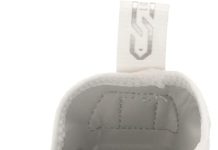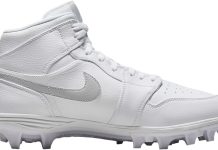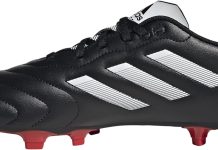Have you ever wondered what sets metal and plastic cleats apart? When choosing the right type of cleats for your specific needs, understanding the differences between these two materials is essential.
Metal cleats are known for their durability and traction, providing excellent grip on various surfaces. On the other hand, plastic cleats offer flexibility and versatility, making them a popular choice among athletes.
This article will explore the distinctions between metal and plastic cleats, helping you make an informed decision for your sporting endeavors.
Traction and Performance
Metal Cleats: Metal cleats are well-known for superior traction and field performance. The metal spikes penetrate the ground, providing excellent grip and stability. This makes metal cleats the preferred choice for sports played on soft or muddy surfaces, such as baseball or softball. The metal spikes dig deep into the ground, allowing athletes to maintain balance and agility, even in challenging conditions. The traction of metal cleats is unparalleled, giving players the confidence to make quick turns and sudden movements without the fear of slipping.
Plastic Cleats: On the other hand, plastic cleats offer a different level of traction and performance. While they may not have the same level of grip as metal cleats, plastic cleats still provide adequate traction for most sports. Plastic cleats suit sports on more complex or artificial surfaces, such as soccer or football. The plastic studs provide enough traction to prevent slippage while running or making sharp turns. Plastic cleats are also more forgiving on artificial turf, as the studs are less likely to get caught or cause damage to the playing surface. Overall, plastic cleats offer a good balance between traction and versatility for various playing conditions.
Surface Compatibility
Metal Cleats: Metal cleats are designed explicitly on natural grass or dirt surfaces. The metal spikes can penetrate the ground and grip the soft terrain effectively. However, metal cleats should not be used on artificial turf or more complex surfaces like concrete, as they can cause damage to the playing area. It is essential to use metal cleats only on surfaces that can withstand the impact of the metal spikes.
Plastic Cleats: Plastic cleats, on the other hand, are more versatile and compatible with various playing surfaces. They can be used on natural grass and artificial turf without causing significant damage. The plastic studs are designed to provide traction on different surfaces, making them suitable for athletes who play multiple sports or participate in leagues that use different playing fields.
Durability
Metal Cleats: Regarding durability, metal cleats have the upper hand. The metal spikes are typically made of steel or other strong metals, ensuring they can withstand rigorous play’s wear and tear. Metal cleats tend to last longer than their plastic counterparts, making them a cost-effective option for athletes who play regularly. However, the metal spikes may require occasional maintenance, such as cleaning and sharpening, to ensure optimal performance and longevity.
Plastic Cleats: While they may not be as durable as metal cleats, they still offer a reasonable lifespan. The plastic studs are made of sturdy materials such as TPU (thermoplastic polyurethane), which can withstand the demands of most sports. However, excessive use or playing on rough surfaces may cause the plastic studs to wear down faster, decreasing traction and performance. Regular inspection and replacement of worn-down plastic studs can help maintain the durability of plastic cleats.
Weight
Metal Cleats: Metal cleats tend to be heavier than plastic cleats due to the material used for the spikes. The additional weight can provide stability and support, especially for athletes requiring more traction and power. However, the weight of metal cleats may be a disadvantage for athletes who prioritize speed and agility, as the added weight can slow them down.
Plastic Cleats: On the other hand, plastic cleats are generally lighter in weight. The absence of metal spikes reduces the overall weight of the cleats, allowing for faster movements on the field. The lighter weight of plastic cleats can be beneficial for sports that require quick bursts of speed and agility, such as soccer or lacrosse. Athletes who value speed and agility may find plastic cleats more suitable for their playing style.
Cost
Metal Cleats: Metal cleats are often considered more expensive than plastic cleats. The materials used for the metal spikes and the manufacturing process contribute to the higher cost. Additionally, the durability of metal cleats contributes to their higher price tag, as they tend to last longer than plastic cleats. However, the investment in metal cleats can be worthwhile for serious athletes who prioritize performance and require superior traction from metal spikes.
Plastic Cleats: Plastic cleats, on the other hand, are generally more affordable compared to metal cleats. The materials used for the plastic studs are less expensive, making them a more budget-friendly option for athletes. Plastic cleats balance cost and performance, making them suitable for recreational players or athletes on a tighter budget.
Safety
Metal Cleats: While metal cleats offer excellent traction and performance, they have a higher risk of injury. The sharp metal spikes can cause accidental injuries to the wearer and other players. It is essential for athletes wearing metal cleats to be cautious and mindful of their movements to minimize the risk of injury. Additionally, metal cleats should not be used on surfaces where they are prohibited, as they can cause damage to the playing area and increase the risk of accidents.
Plastic Cleats: Plastic cleats, on the other hand, offer a safer option for athletes. The absence of sharp metal spikes reduces the risk of accidental injuries, making plastic cleats more suitable for sports with frequent physical contact, such as soccer or rugby. Plastic cleats are also less likely to cause damage to the playing surface or other players, further enhancing the overall safety on the field.
Maintenance
Metal Cleats: Metal cleats require regular maintenance to ensure optimal performance and longevity. The metal spikes can collect dirt, mud, or grass during play, reducing their traction and effectiveness. Cleaning the metal spikes after each use and removing debris or build-up will help maintain their performance. The metal spikes may also require occasional sharpening to ensure they can penetrate the ground effectively.
Plastic Cleats: Plastic cleats, on the other hand, are generally easier to maintain than metal cleats. The plastic studs are less likely to accumulate debris, making cleaning more straightforward. However, inspecting the plastic studs regularly for signs of wear or damage is still important, as worn-down studs can affect traction and performance. Replacing any worn-out studs will help maintain the optimal performance of plastic cleats.
Customization
Metal Cleats: Metal cleats offer more customization options than plastic cleats. The removable nature of metal spikes allows athletes to choose from different spike lengths and designs, depending on their preferences and playing conditions. This flexibility in customization allows athletes to tailor their cleats to their specific needs, further enhancing their performance on the field.
Plastic Cleats: While plastic cleats may not offer as many customization options, some models allow for limited customization. Athletes can choose from different colors and designs for their plastic cleats, adding a personal touch to their on-field attire. Though not as extensive as metal cleats, this level of customization still allows athletes to express their style and individuality.
Regulations and Restrictions
Metal Cleats: Metal cleats are subject to regulations and restrictions in certain leagues and organizations. These restrictions may be in place to protect playing surfaces, prevent injuries, or maintain a level playing field. Athletes need to be aware of the rules and regulations regarding using metal cleats in their sport or league. Violating these regulations can result in penalties or disqualification from games.
Plastic Cleats: Plastic cleats, being more versatile and less damaging to playing surfaces, are generally allowed in most sports and leagues. However, it is still essential for athletes to ensure that their plastic cleats comply with the regulations set by their respective sports or leagues. Rules regarding stud length and material may be in place to ensure fair play and prevent injuries.
Comfort
Metal Cleats: While providing excellent traction, metal cleats may not always offer the same level of comfort as plastic cleats. The metal spikes can be felt underfoot, which may cause discomfort or foot fatigue, especially during long periods of play. Some metal cleat models, however, are designed with additional cushioning and support, aiming to provide a more comfortable experience for athletes.
Plastic Cleats: Plastic cleats often prioritize comfort, with many models featuring cushioning and support for the wearer. The absence of metal spikes eliminates the discomfort caused by their presence, allowing athletes to focus on their game without distractions. Plastic cleats with padded insoles or ankle support provide additional comfort for athletes who value a comfortable fit.
In conclusion, the choice between metal and plastic cleats depends on various factors such as the playing surface, performance requirements, budget, and personal preferences. Metal cleats offer superior traction and durability but have a higher risk of injury, higher cost, and heavier weight.
Plastic cleats, on the other hand, provide adequate traction, versatility, affordability, and safety. Ultimately, athletes should consider their specific needs and playing conditions to make an informed decision about the type of cleats that will enhance their performance and overall enjoyment of the game.





































